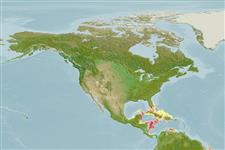Teleostei (teleosts) >
Blenniiformes (Blennies) >
Labrisomidae (Labrisomids)
Etymology: dropi: Named for the Smithsonian Institution’s Deep Reef Observation Project (DROP); noun in the genitive case.
Eponymy: Not an eponym but named for the Smithsonian Institution’s Deep Reef Observation Project (DROP). (Ref. 128868), visit book page.
Environment: milieu / climate zone / depth range / distribution range
Ecology
Marine; reef-associated; depth range 157 - 167 m (Ref. 93751). Tropical
Western Central Atlantic: southern Caribbean, Curaçao.
Size / Weight / Age
Maturity: Lm ? range ? - ? cm
Max length : 2.2 cm SL (female)
Short description
Identification keys | Morphology | Morphometrics
Dorsal spines (total): 12; Dorsal soft rays (total): 12; Anal spines: 2; Anal soft rays: 19; Vertebrae: 36. This species is distinguished from its congener (apectolophus) by the following set of characters: DL III-I-XIII,12; A 19; pectoral-fin rays 12; precaudal vertebrae 12; first dorsal-fin spine longer than second dorsal-fin spine; no scales; posterior nostril without fleshy flap; trunk, dorsal and anal fins with spotted pigment pattern in preservative (Ref. 93751).
Life cycle and mating behavior
Maturity | Reproduction | Spawning | Eggs | Fecundity | Larvae
Baldwin, C. and R. Robertson, 2013. A new Haptoclinus blenny (Teleostei, Labrisomidae) from deep reefs off Curaçao, southern Caribbean, with comments on relationships of the genus. ZooKeys 306(2013):71-81. (Ref. 93751)
IUCN Red List Status (Ref. 130435: Version 2024-2)
Threat to humans
Harmless
Human uses
Tools
Special reports
Download XML
Internet sources
Estimates based on models
Phylogenetic diversity index (Ref.
82804): PD
50 = 0.7500 [Uniqueness, from 0.5 = low to 2.0 = high].
Bayesian length-weight: a=0.01000 (0.00244 - 0.04107), b=3.04 (2.81 - 3.27), in cm total length, based on all LWR estimates for this body shape (Ref.
93245).
Trophic level (Ref.
69278): 3.1 ±0.3 se; based on size and trophs of closest relatives
Fishing Vulnerability (Ref.
59153): Low vulnerability (10 of 100).
